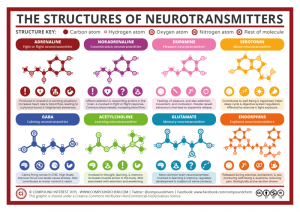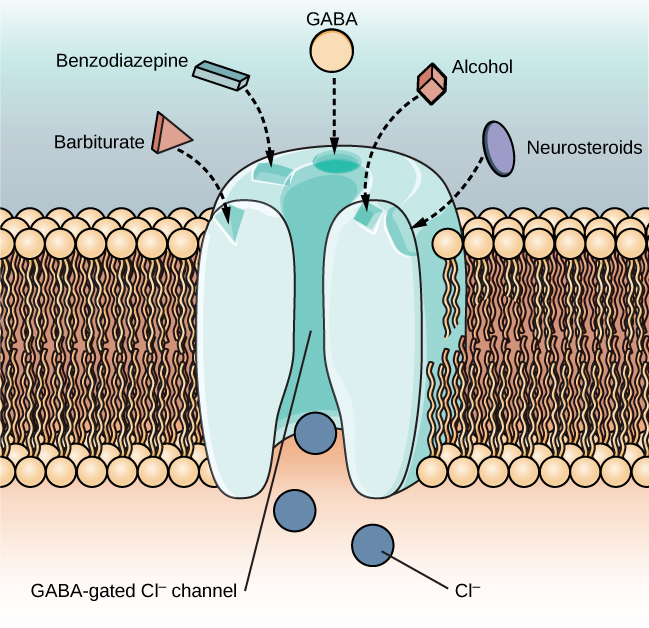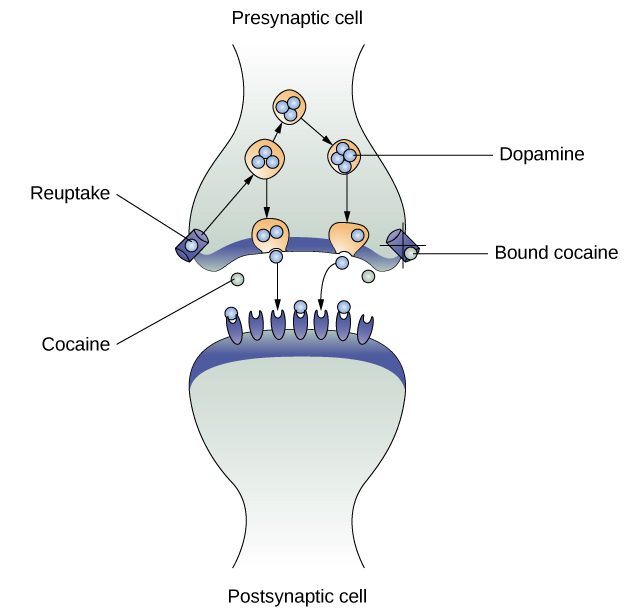4.5 The Impact of Substances on the Brain
Have you ever experienced an altered state of consciousness? If you sleep on a regular basis, you have! Sleeping is one way in which our mind is transformed. Remember our discussions on caffeine? Even a cup of coffee has an impact on your brain! Here we will discuss the various substances and their impact on the brain.
Depressants

As we discussed earlier, alcohol is a depressant, which tends towards reducing central nervous system activity. Depressants serve as agonists of the Gamma-Aminobutyric Acid (GABA) neurotransmitter system. Because GABA has a quieting effect on the brain, GABA agonists also have a quieting effect; these types of substances are often prescribed to treat both anxiety and insomnia.

The GABA-gated chloride (Cl-) channel is embedded in the cell membrane of certain neurons. The channel has multiple receptor sites where depressants bind to exert their effects. The binding of these molecules opens the chloride channel, allowing negatively-charged chloride ions (Cl-) into the neuron’s cell body. Changing its charge in a negative direction pushes the neuron away from firing; thus, activating a GABA neuron has a quieting effect on the brain.As noted with the various substances in Chapter 3, the physical dependence to depressants, particularly alcohol can be life threatening. Withdrawal management is done in a medical facility under the supervision of health care providers.
Stimulants
Stimulants are substances that increase overall levels of neural activity. Many of these substances act as agonists of the dopamine neurotransmitter system. Dopamine activity is often associated with reward and craving; therefore, substances that affect dopamine neurotransmission can be misused.

As one of their mechanisms of action, cocaine and amphetamines block the reuptake of dopamine from the synapse into the presynaptic cell.
Stimulants like cocaine, amphetamine and MDMA create a euphoric high, feelings of intense elation and pleasure, especially in those who take the substance via intravenous injection or smoking.
Food For Thought
- Do you use caffeine? If yes, how much?
- When do you consume your caffeine and where does it come from? Soda, coffee, energy drinks?
- Compare the amount of caffeine in energy drinks, soda, coffee and tea from an evidence based source. What is a safe amount of daily caffeine consumption?
Nicotine is associated with increased risks of heart disease, stroke, and a variety of cancers. Nicotine exerts its effects through its interaction with acetylcholine receptors. Acetylcholine functions as a neurotransmitter in motor neurons. In the central nervous system, it plays a role in arousal and reward mechanisms. Nicotine is most commonly used in the form of tobacco products like cigarettes or chewing tobacco; therefore, there is a tremendous interest in developing effective smoking cessation techniques. To date, people have used a variety of nicotine replacement therapies in addition to various psychotherapeutic options in an attempt to discontinue their use of tobacco products.
Opioids[1]
Opioids are substances that include heroin, morphine, methadone, and codeine. Opioids have analgesic properties; that is, they decrease pain. Humans have an endogenous opioid neurotransmitter system—the body makes small quantities of opioid compounds that bind to opioid receptors reducing pain and producing euphoria. Thus, opioids mimic this endogenous painkilling mechanism. There are both natural opiates, opium, which is a naturally occurring compound found in the poppy plant and synthetic versions of opiates that have very potent painkilling effects. These are the substances, like fentanyl, that you may hear in the news.
Hallucinogens[2]
Hallucinogens alter sensory and perceptual experiences. In some cases, people experience vivid visual hallucinations. It is also common for these types of substances to cause hallucinations of body sensations (e.g., feeling as if you are a giant or can fly) and a skewed perception of the passage of time. As a group, hallucinogens are incredibly varied in terms of the neurotransmitter systems they affect. Mescaline and LSD are serotonin agonists, and ketamine (an animal anesthetic) act as antagonists of the NMDA glutamate receptor.
Let us review your learning and try the drag and drop activity below.
Chapter Credit
Adapted from Unit 1.2 in Drugs, Health & Behavior by Jacqueline Schwab. Content condensed and rewritten to improve clarity.
Image Credits
- Diagram of the Structure of Neurotransmitters from: Compound Interest (2015), shared under CC BY-NC-ND 4.0.
- GABA-gated chloride channel diagram from the unit Substance Use and Abuse in Psychology 2e by Spielman et al published by OpenStax under a CC BY licence.
- Presynaptic and postsynaptic diagram from the unit Substance Use and Abuse in Psychology 2e by Spielman et al published by OpenStax under a CC BY licence.

